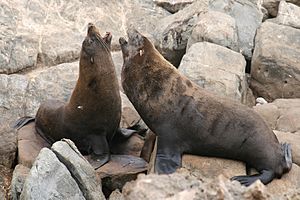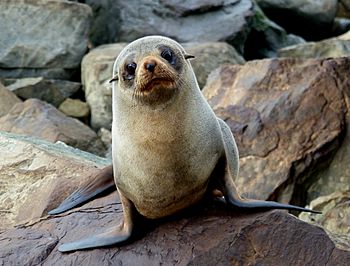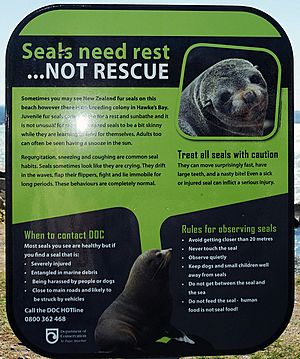Arctocephalus forsteri facts for kids
Quick facts for kids Arctocephalus forsteri |
|
|---|---|
 |
|
| Conservation status | |
| Scientific classification | |
| Genus: |
Arctocephalus
|
| Species: |
forsteri
|
 |
|
| Distribution of the New Zealand fur seal | |
The Arctocephalus forsteri is a type of fur seal. It is often called the Australasian fur seal, South Australian fur seal, New Zealand fur seal, Antipodean fur seal, or long-nosed fur seal. In New Zealand, people usually call it the New Zealand fur seal. The Māori name for this seal is kekeno.
These seals live mostly around southern Australia and New Zealand. Even though the seals in Australia and New Zealand have some small genetic differences, they look very similar. Because of this, they are still considered the same species. In the past, hunting by humans greatly reduced their numbers, almost making them disappear.
Contents
What They Look Like
Male fur seals are much bigger than females. Males can weigh up to 160 kilograms (about 350 pounds) and be 2 meters (over 6 feet) long. Females are smaller, weighing about 30–50 kilograms (66–110 pounds) and growing up to 1.5 meters (about 5 feet) long.
Baby seals, called pups, weigh about 3.3–3.9 kilograms (7–8.5 pounds) at birth. They are about 40–55 centimeters (16–22 inches) long.
These seals have visible outer ears. Their back flippers can rotate forward, which helps them walk on land. This is a key difference from other types of seals. They have a pointy nose with long, light-colored whiskers.
Their bodies are covered in two layers of fur. The fur is grey-brown on their back and lighter on their belly. Some seals have white tips on their longer hairs, which can make them look a bit silvery.
Where They Live
New Zealand fur seals live in both Australia and New Zealand. In Australia, you can find them along the coast and on islands in the south. This includes areas from Western Australia to South Australia, and also in Tasmania and Macquarie Island. Smaller groups are now appearing in Victoria and southern New South Wales.
Before people arrived in New Zealand, these seals lived all around the main islands and smaller islands nearby. Now, their groups are growing and spreading. You can find them around the entire South Island, on Stewart Island, and on all the New Zealand subantarctic islands. New breeding groups have also started on the North Island.
How They Behave
Diving Deep
New Zealand fur seals are amazing divers. They can dive deeper and stay underwater longer than any other fur seal. When they swim fast in the ocean, they can jump out of the water like dolphins.
Female seals can dive for about 9 minutes and go as deep as 312 meters (over 1,000 feet). They tend to dive deeper and longer in autumn and winter. Males can dive for about 15 minutes and reach depths of about 380 meters (over 1,200 feet). On average, though, they usually only dive for 1–2 minutes.
When hunting for food, they dive deeper during the day. This is because their prey often moves to deeper waters when it's light. At night, they dive shallower as their prey moves closer to the surface.
Female seals who are feeding their pups change their diving habits. They make shorter dives, usually around 5 minutes. This allows them to return to their pups more often. Males and females often hunt in different areas, so they don't compete for the same food. Males usually hunt in deeper waters, while females stay closer to the coast.
Young pups start learning to dive when they are about 6–10 months old. This is before they stop drinking their mother's milk. They need to learn how to hunt at night. This time is risky for pups, and many do not survive. They start by eating soft creatures like squid and then move on to fish.
Talking to Each Other
Male seals make different sounds like barks or whimpers. These can be threats or signs of giving up. Females growl and also make a high-pitched call to attract their pups. This call helps them find their babies from far away. Once they are close, mothers use their sense of smell to make sure it's their own pup.
Male seals also show off their necks to other males. This is a way to show who is stronger without actually fighting.

Having Pups
Female seals are ready to have babies when they are 4 to 6 years old. Males are ready later, between 8 and 10 years old. One male seal will mate with several females.
Males arrive at the breeding areas in late October to claim their territory. Females usually mate once a year, about eight days after giving birth. The fertilized egg does not attach to the mother's womb for about 3 months. Then, the baby grows for 9 months. Females can keep having pups until they are about 14 to 17 years old.
Females come ashore between November and January, just a few days before their pups are born. They stay close to the birth spot for up to ten days. When they are about to give birth, they become restless. Birth can take up to five hours. After the pup is born, the mother sniffs it often to remember its scent. This helps her find the pup after she goes out to sea.
Pups are quite developed at birth. Within an hour, they start drinking their mother's milk. They will suckle for about 7 minutes at first, and later for over 33 minutes.
Mothers may leave their pups to swim after 45 minutes to 3 days. They go on longer feeding trips after 6–12 days. Even then, mothers usually don't leave their pups for more than 2 days. When pups are about 21 days old, they gather in small groups while their mothers are away. When mothers return, they only feed their own pups and can be unfriendly to other pups.
Mothers with male pups tend to make longer feeding trips than mothers with female pups. Pups start eating solid food just before they stop drinking milk. They usually stop drinking milk around September and then go off on their own.
Many pups die from natural causes like starvation, getting stuck in their birth sac, being stillborn, or being trampled. Humans can also cause pup deaths through handling or being too close to them.
What They Eat
New Zealand fur seals eat a variety of food. Their diet includes squid, octopus, fish, and even birds. Octopus and arrow squid are a big part of their diet. Seals living in the southern parts of their range have been known to eat penguins.
Scientists have studied the contents of their stomachs. They found fish like anchovy, barracuda, flounder, and red cod. By looking at tiny ear bones from fish found in seal droppings, they learned that lantern fish, anchovies, and hoki are common fish they eat. Their diet can change depending on the season, their sex, if they are breeding, and the ocean conditions.
Who Hunts Them
The main predators of New Zealand fur seals are killer whales and sharks. Male New Zealand sea lions also hunt them, especially young pups. Leopard seals might also hunt them.
How Humans Affect Them
Before humans arrived, these seals lived all over New Zealand. The first settlers, the Maori, hunted them, which reduced their numbers. Later, European hunters nearly wiped them out between the 18th and 19th centuries.
Today, fishing is a major threat to New Zealand fur seals. They often get caught in fishing nets and drown. Studies in the Kaikoura area found that seals often get tangled in fishing nets and plastic straps. Many tangled seals can be rescued and survive. However, it is thought that over 10,000 seals may have drowned in nets between 1989 and 1998.
Some seals are also shot by fishermen who think the seals interfere with their fishing. It's not known how often this happens, but groups that protect animals believe this problem will get worse. In 2015, some politicians in Australia suggested discussing whether to allow seal culling (killing) because of conflicts with fishing. However, killing long-nosed fur seals is still against the law.
Human activity near seal breeding areas can also cause stress and panic, which can indirectly lead to pup deaths. Even putting metal tags on pups' ears has been linked to health problems for the pups.
Protecting the Seals
In Australia
In Australia, the New Zealand fur seal is protected by the Environment Protection Biodiversity Conservation (EPBC) Act 1999. This law lists it as a protected marine species. The species is also protected by laws in different Australian states:
| State | Protection Status | Law |
|---|---|---|
| New South Wales | Vulnerable | Threatened Species Conservation Act 1995 (NSW) |
| South Australia | Marine mammal | National Parks and Wildlife Act 1972 (SA) |
| Tasmania | Rare | Threatened Species Protection Act 1995 (TAS) |
| Victoria | Protected | Wildlife Act 1975 (Vic) |
| Western Australia | Other protected fauna | Wildlife Conservation Act 1950 (WA) |
In 2000, a large Marine Park was created near Macquarie Island to help protect these seals. The Tasmanian government also extended the protected area around Macquarie Island.
In New Zealand
In New Zealand, the Marine Mammals Protection Act 1978 protects these seals. This law helps to save marine animals. It states that no one can touch or feed any wild seals.
Gallery
-
At Castlepoint, New Zealand
See also
 In Spanish: Lobo marino de Nueva Zelanda para niños
In Spanish: Lobo marino de Nueva Zelanda para niños







